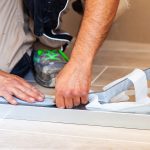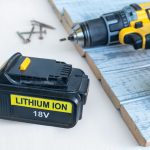Having a safe job site extends beyond just the traditional safety and health training of your workers. Advances in technology have created new ways to keep employees safe while on the job site. New technologies for the job site range from drones to protective equipment, wearables and more. Using these new forms of technology makes it easier to keep track of where workers are and what they’re doing, as well as providing a way to address various site and occupation risks.
Safety on the job site extends beyond simply training

Construction workers wearing the Spot-R Clip on the job site. Photo courtesy of Triax Technologies.
Drones
Minneapolis-based Mortenson recently started using drones to map, plan and manage complex site work. For the $505 million Mercyhealth Hospital and Trauma Center-Riverside in Rockford, Ill., drones delivered precision video and images with dimensional data of the 65-acre site in near real time. According to Tom Simon, general superintendent at Mortenson, the builder was able to integrate the drone-captured data and images with the project’s BIM and other software tools to enhance decision-making.
Using a 30-minute, predetermined flight path and height, the drone was able to do the work of two people surveying and gathering data on-site for two full days, and then producing a report a week later. The drones provide video and data that are more accurate, Simon says, helping make decisions about siting temporary entrances, exits and parking, as well as tracking the installation process of permanent roads, parking lots and underground utilities.
By merging drone-generated images with other data, Mortenson is able to create Google Earth-like images that can be pulled up on a big screen TV in the construction site trailer. Subcontractors in the field have iPads for accessing a cloud-based BIM360 Glue program that facilitates 3-D coordination, and allows them to have the most up-to-date versions of project plans to manage their work, resolve conflicts and avoid rework.
Simon notes that the drone images and video give a full 360-degree view of the site, enabling everyone in understanding where the different crews are setting up and moving to. Visuals can be used to point out work locations for the day, and notify the team of site changes or ongoing work that they need to be aware of. Superintendents can also use the image to spot any potential issues, such as workers getting too close to the wetlands. And, Simon says, drones can reduce or eliminate he need for someone to visually inspect hard-to-reach or potentially dangerous locations, such as confined space installation, structural steel and safety rails and systems.
“The drones have proven incredibly versatile and useful at the Mercyhealth project,” Simon says, “helping the team stay safe and on schedule and supporting quality efforts. The information, videos and images the drones provide have made it easier to communicate, coordinate and successfully run such a complex site.”

Gilbane employee using iPads on a job site while wearing the Kask helmet. Photo courtesy of Gilbane Building Co.
Protective Equipment
Safety on the job site begins with the personal protective equipment (PPE) used to keep workers safe, including hard hats, high visibility vets, steel-toed boots, gloves and glasses, which are required for preventing injuries and saving lives. The hard hat is one of the pieces of equipment that hasn’t changed much over the years. But new safety helmets from KASK America Inc., Charlotte, N.C., have really upped the game in recent years. The addition of a chin strap as well as the ability to integrate hearing and eye protection, while providing additional protection from front, rear and side impacts, was enough for Providence, R.I.-based Gilbane Building Co. to try out the new Kask safety helmets.
Starting in late 2017, Rebecca Severson, vice president and corporate director of safety at Gilbane, says the Safety Peer Group adopted Kask helmets on their job sites as part of the PPE requirements, and the company now has more than 5,200 helmets in the field. Severson says the new helmets are safer, lighter and more comfortable than a traditional hard hat, are good for a 10-year period and have a greater service life. “These helmets have a strap, so they’re going to stay on the head if there’s any type of impact,” Severson says. “And they absorb the impact greater than the traditional hard hat.”
This is especially helpful in avoiding injury from a secondary impact, whether it is from hitting the floor or the building. “We’ve had some success stories already,” Severson adds. “I know way back when I was a brand new safety manager, I fell on a roof and my hard hat went flying. I’ve heard stories of some of our project managers that say that they’ve recently fallen on a roof, but their helmet stayed on and they’ve had no issues whatsoever. So I’ve been very happy with the way that it’s performing, and I really, truly believe in them.”
While Severson acknowledges the Kask helmets are more expensive than traditional hard hats, the added cost is worth it. “I feel like it’s the right thing to do for our employees,” she says. “If we know of something that’s better in the industry, why aren’t we giving our employees the best PPE out there? We do it for our gloves, we do it for other types of PPE, why aren’t we protecting their most important organ the same way?”

The Spot-R EvacTag. Photo courtesy of Triax Technologies.
Wearables
In addition to the new Kask helmets, employees at Gilbane are also using the Spot-R clip from Triax Technologies, Norwalk, Conn. The Spot-R clip is a small wearable device that detects falls at the job site, identifying who, where and distance of the fall. “It provides us a very quick response should the device detect a fall,” Severson explains. “And it’s able to detect a fall from various heights. It doesn’t necessarily need to be a huge 6-foot fall, but it can be a smaller fall.”
According to Ian Ouellette, vice president of product at Triax, the Internet of Things (IoT)-based device improves injury response times by up to 91 percent. “By activating the push-button alert at the bottom of the Clip, workers can report worksite hazards or signal distress to designated supervisors from anywhere on-site.”
While fall detection was the primary focus of using Spot-R, Severson says the company has implemented a number of additional functions that are also creating a safer job site. One of the things Triax created is evacuation tags used in conjunction with the Spot-R Clips. “If a building needs to be evacuated because of a fire or other reason, we have access to a dashboard where we can hit a single button and it will set off the evacuation alarm,” Severson explains. The Spot-R EvacTag sets off a blaring, flashing alarm where installed around the job site, as well as an alarm on the individual Spot-R Clips. “It basically alerts everyone to evacuate the building, and you can evacuate so much quicker than you would the traditional method,” she adds.
Spot-R EquipTags are equipment tags that monitor real-time equipment location, operator identity and more. As Severson explains, each person who is assigned a Spot-R Clip has a profile that you can add training certifications. “For example, if someone is certified to use a forklift, that can be added to their profile, and when they get into a forklift, their personal tag matches the equipment tag and they’re all set,” she says. “But, let’s say that person has a bulldozer-type equipment certification and gets into a forklift. Since those two don’t match, it would send an alert to the superintendent, who would be able to correct the issue.”
Today, the need for IoT technology is growing and contractors are taking a very strategic, enterprise-wide approach to its adoption and implementation.
Additionally, Severson says they’ve started using Spot-R for as a point of entrance device as well as being able to create a perimeter around certain areas. “Let’s say I want to keep people out of a certain area, or only allow access for certain people in a certain area. I can set a perimeter around a tag and if authorized people come through the area, it’s no big deal, but if someone who’s not authorized to go through the area does, it would send an alert to the superintendent that the zone has been breached, allowing them to follow up and make sure they understand that it is a limited access zone.”
The Spot-R Clip automatically connects to the Spot-r network, monitoring when workers arrive on-site, automating time and attendance, and providing real-time workforce location by floor and zone. “The most important benefit is the complete visibility that it offers,” says Ouellette, “which is critically needed to improve safety and productivity on a chaotic job site, with many tradesmen, subcontractors and employees working in various locations.”
“This complete visibility into the job site is invaluable,” Ouellette adds. “The Spot-R Clip promotes accountability among workers and reinforces a safety mindset for modifying and avoiding potentially risky behaviors.”





